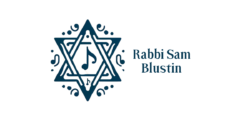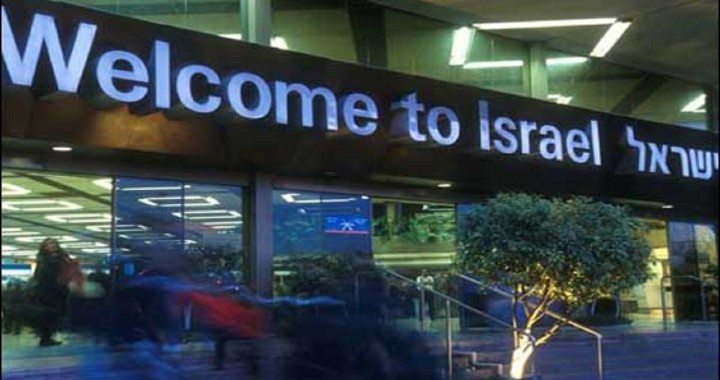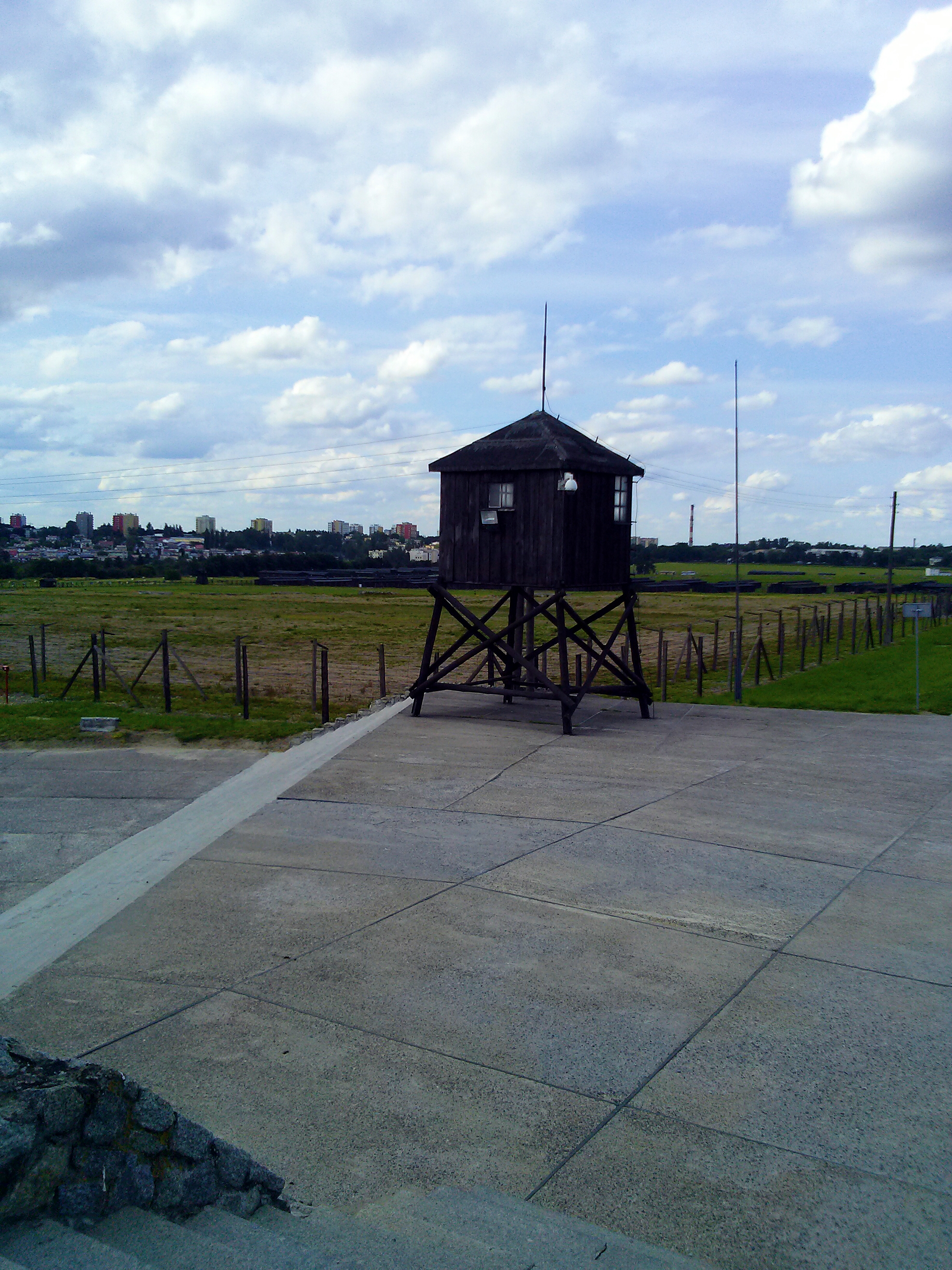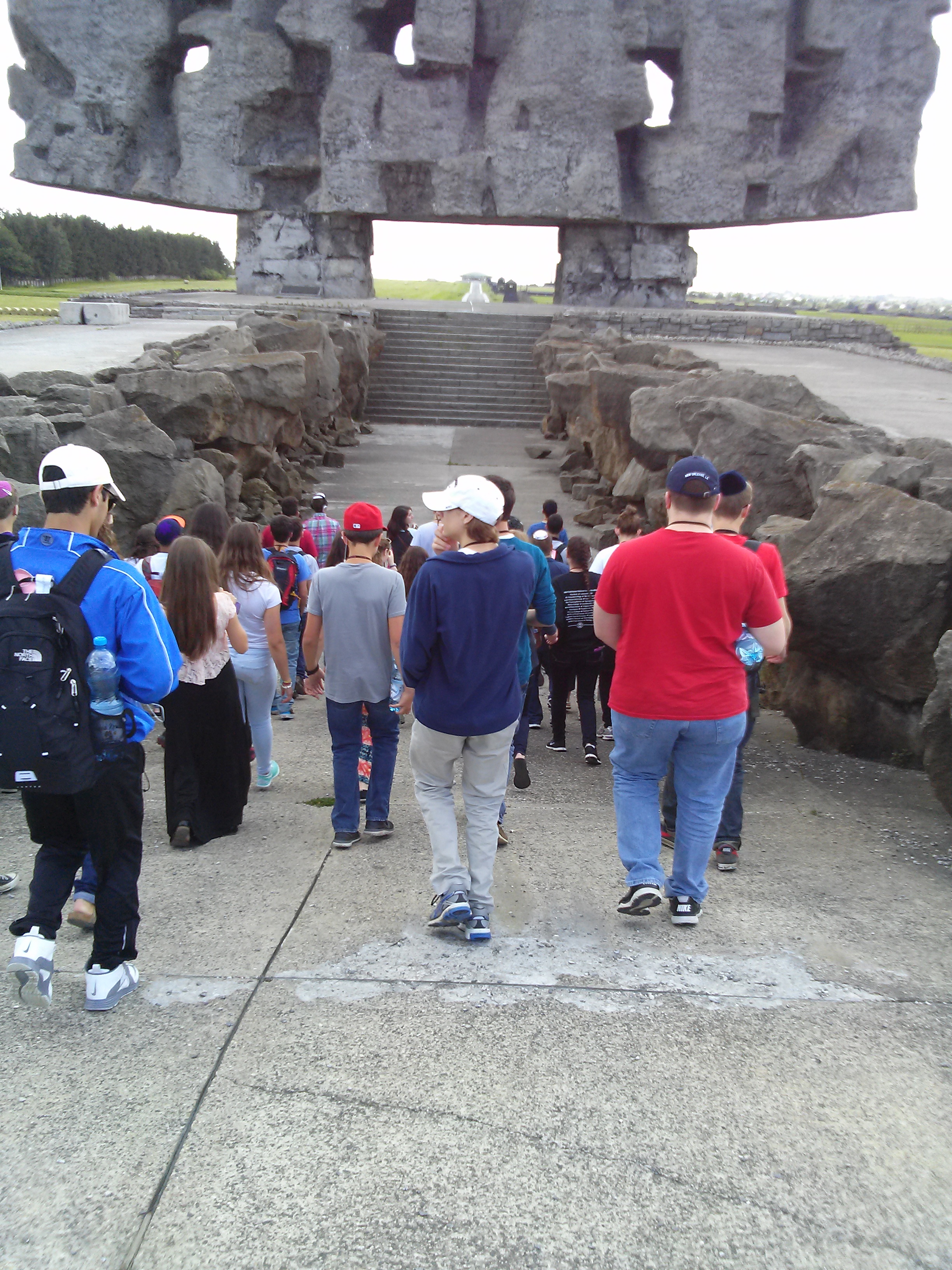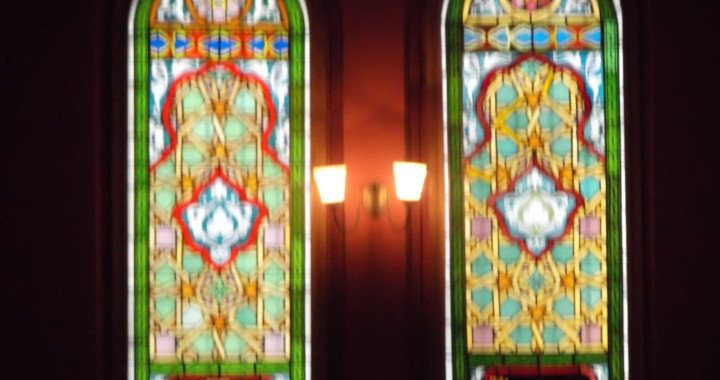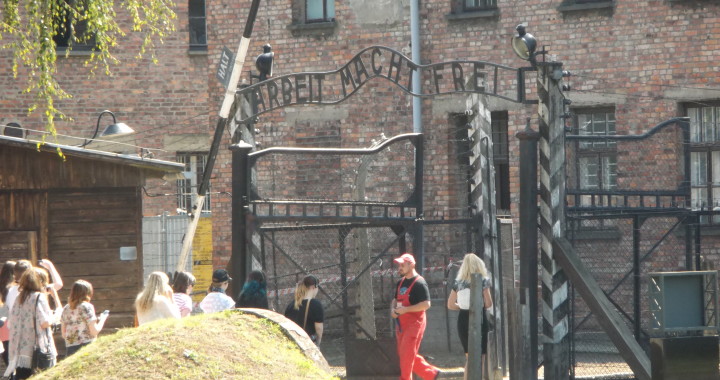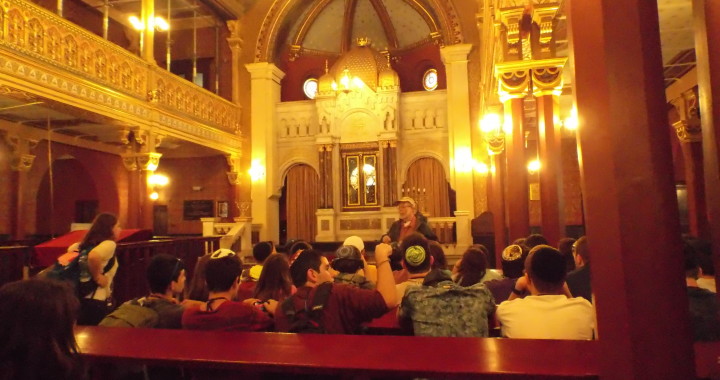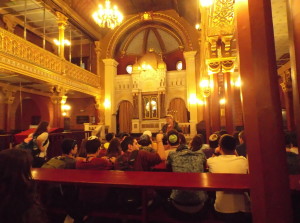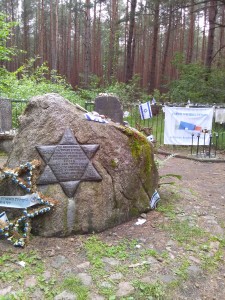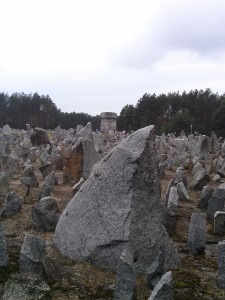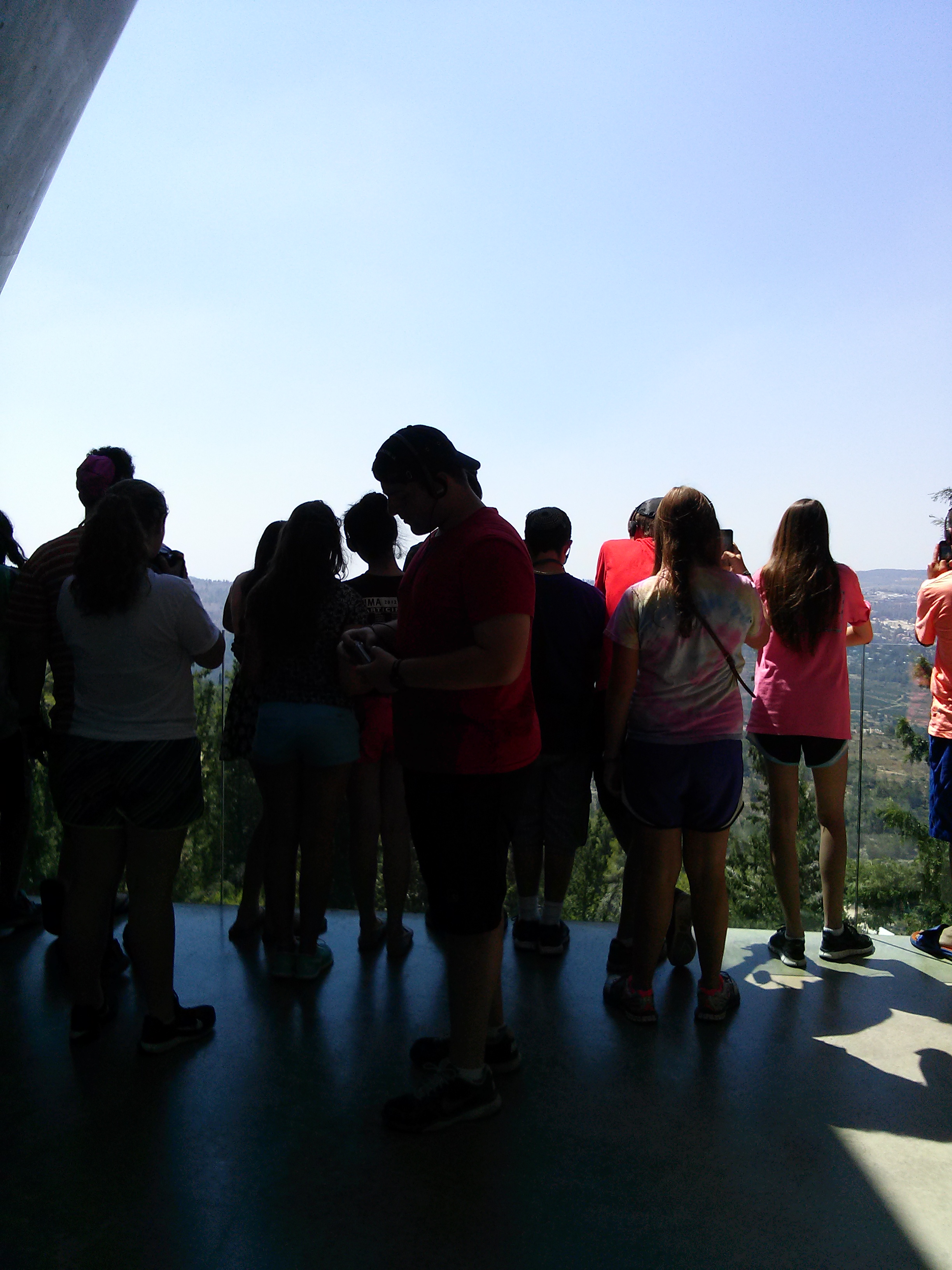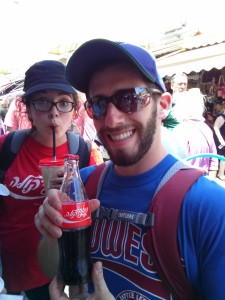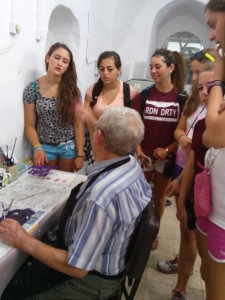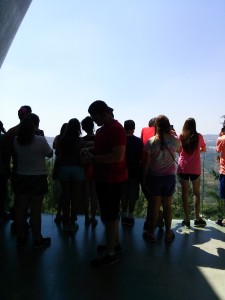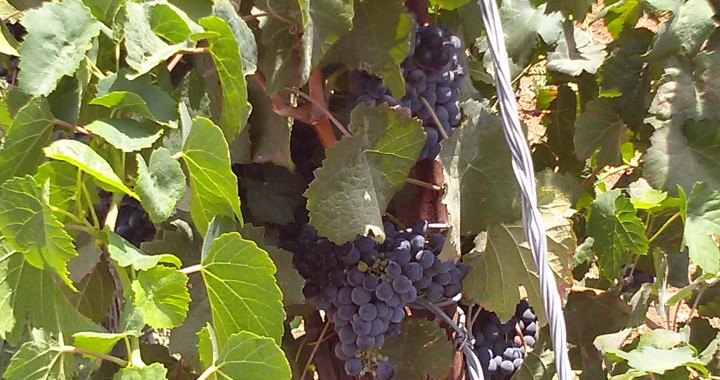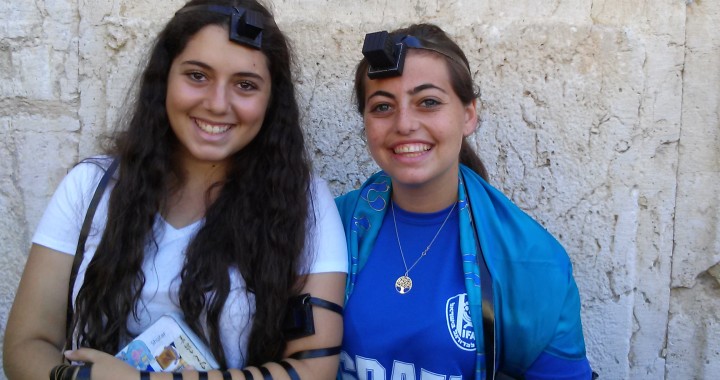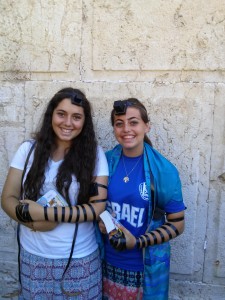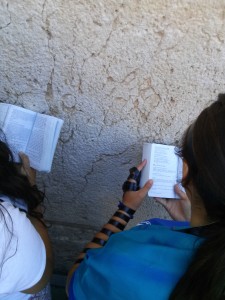Welcome to my Israel blog! Over the next year, you’ll be able to follow my travels as I shepherd 42 high school upperclassmen through a week in Poland and 4 in Israel, as well as my own personal adventures traveling and studying in Israel at the Conservative Yeshiva.
I sit here on the plane to Newark, NJ, just having left my family, ready to begin leg one of this journey: USY staff training. I don’t believe my mind has quite processed the fact that I’ll be in a foreign country for a year, but I’m sure that will come soon. Until then, I guess it’s best just to keep plowing ahead into the unknown, taking the challenges as they come!
More to come, so check back frequently for new posts!
L’hitraot, or until next time,
Sam
Category Archives: Experiences
Follow my experiences in Israel this year!
A Journey From Darkness To Light
Today was the first full day of our Poland Israel trip, and it was jam packed. We woke up in Warsaw, and continued our tour learning about Polish Judaism prior to World War II. We learned about the Warsaw ghetto, and stopped at some of the few remaining sites still standing from after the uprising, as well as visited many of the monuments erected in honor of our heroes.
We ended our walking tour at the new History of Polish Jewry museum, where we became the first USY group ever to get a tour there. We learned about the rich history of the more than 3.5 million Polish Jews who served in some of Poland’s most influential and powerful occupations, and how all but 10% survived the Shoah. Although the museum’s main exhibit does not open until December, we found out about the deep meaning of the exodus inspired architecture and had a few minutes to wander through the rotating exhibit.
We then made the journey from Warsaw to Lublin, which prior to the war, had a Jewish population equal to a third of Lublin’s total population. We headed straight to the Majdanek concentration camp, where we entered by a large stone statue. We walked town the steep ramp in front of the monument with ease, and walked through a long walkway ending in an even steeper climb up stairs, symbolizing the even tougher journey to surviving the camp.
We then headed to the main gate of the camp, passing through double barbed wire fences. On the right was a sterilization room, with showers and a bath, and which all prisoners went first upon arrival. Towards the back of the building was an added on gas chamber for those unfit to work. Leaving the building, we walked along a row of administrative buildings used by the SS. One building was filled with rows of thousands of shoes, all from real victims who lost their lives at the camp.
To the left of these buildings stood the fields, where the barracks of the prisoners stayed. Rows and rows of bunks lined the rooms, and each would cram 500+ prisoners into the most cramped and terrible conditions possible. We walked through these fields, down to the far end of the camp where the crematorium sat. Walking through, there were rooms for execution, medical examination, and finally the stoves where bodies were burned.
Just outside of the crematorium stood a big circular monument, and inside showed a huge mountain of human ashes recovered from the site. Ashes from real people who lost their lives. As we finished our ceremony there, hundreds of crows stirred in the neighboring field, simultaneously taking flight, cawing and dispersing in all directions. It was both an eerie and powerful moment.
We left Majdanek and davened Mincha in the Yeshiva Chochmei Lublin, a beautiful prayer space with a vibrant acoustic. Afterwards, the USYers split into chevruta, studying Daf Yomi, the daily Talmud, in the same Yeshiva created by the founder of Daf Yomi.
There was a mix up with dinner, so we headed back to the hotel for some free time while staff scrambled to find a substitute. The USYers handled the delay amazingly, and at around 8:30 we had dinner one.
Following Birkat, we broke into subgroups of 9 and debriefed on the day with the USYers. We talked about the powerful moments, the moving ones, and the confusing ones, and came to the conclusion that throughout Poland, and the rest of the trip, that leaning to balance experiences and emotions would allow us to get the most out of our experience. We needed to balance out sadness and disgust with a feeling of am yisrael chai, balance our picture taking with living in the moment, and balance our seriousness with elation.
While waiting for our restaurant to set up our midnight second (originally planned) dinner, the USYers broke out into an impromptu song session, and it was really a magical moment and one that will strengthen the group.
Now it’s long past my bed time, so check back for more to come in the days ahead. I’m not sure I can write this much every time, but I’ll do my best.
Lilah Tov,
Sam
Shabbos in Krakow
If I had had USY experiences like this, I would have done more USY.
Shabbat this weekend was simply amazing, and it was a much needed reminder that while the Nazis may have killed many of our children, Judaism and passion for Jewish music and t’fillah is not lost in this generation, but in fact it’s thriving.
We started shabbat with a spirited and harmony filled Kabbalat Shabbat and Ma’ariv, followed by a delicious dinner. After dinner, we moved into a circle and sang z’mirot, or Jewish songs for a solid half hour or more. This group of USYers love to sing, and do so at every possible opportunity.
Saturday morning, we attending synagogue at the Temple Shul, where the Jewish culture festival had brought in three cantors from Israel to lead services in this beautiful Shul. It was an interesting, orthodox style service, where there was little singing and much davening. A choir came out for Musaf, which was pretty cool and sounded great. You don’t get to daven at that old of a synagogue with that much history too often, so it was definitely worth the experience. After lunch, we walked back to the hotel and had extended minucha, or rest time.
We ended shabbos with some pirkei avot study, Mincha, dinner (where I told the story of Moshele Gut Shabbos), ruach singing, Ma’ariv, and a spirited havdallah.
It’s extremely refreshing after working with younger kids for so long, and with kids who may not be as knowledgeable Jewishly, to be with a group of young Jewish leaders. Week one is over, and I can’t wait for 4 more in Israel.
Never Forget
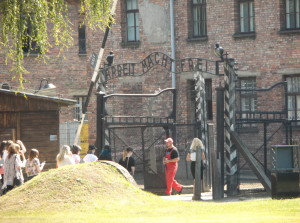
At perhaps the most well known of all concentration camps, Auschwitz – Birkenau was perhaps the most impactful of our experiences in Poland. We started the day at Auschwitz I, which was as much of a museum as it was a complete picture of what life was like there. Entering through the iconic gates that say “work will set you free”, we saw exhibits detailing the vast distances people were transported to get to the camp, as well as a picture of the different bunking conditions throughout the camp’s history (in case you were wondering, inmates started out sleeping on straw, which were later “upgraded” to mats, and eventually bunks, which were still extremely overcrowded).
We entered the new Jewish building, which focused on the lives of individual Jews before and during the war. The first room was filled with projections on the walls filled with videos, many homemade, of Jews with their families and friends. Upstairs, we entered the propaganda room, which displayed speeches from various Reich leaders translated on a series of screens demonizing the Jewish people. The next room was a simple design, with real children’s artwork drawn like pencil sketches on white walls from pre-war times. It was heartbreaking to imagine all of the young lives lost, and the potential they had to change the world wasted. The last room was the hall of names, where they had listed in a giant book like display the known names of 4 million+ that perished in the holocaust.
As we left the building, our guide Jules so poignantly stated, “When Jews arrived at Auschwitz, their names were replaced by numbers. It’s exhibits like this, and people like you, that give those who perished their names back.”
Birkenau was another experience entirely. This enormous death and labor camp, which had 4 crematorium, is quickly deteriorating to the point that if preservation measures aren’t enacted soon, any remaining structures may be reduced to rubble as many structures already have.
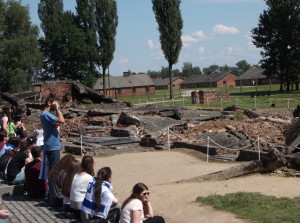
We grow up learning about the holocaust, and are told to never forget, but it’s not until the fragility of human life and remnants of the holocaust are experienced can we really gain an understanding for the importance and urgency of holocaust education.
We must teach. We must experience. We must teach the value of human life to our children. And we must never forget.
Synagogues, Synagogues, Synagogues
Thursday was a day filled with travel and synagogues. We started our day by traveling to the Temple Synagogue in Krasnik, where we davened shacharit in the old, run down synagogue.
After a moving service where we brought Judaism back to a town where there were no Jews left, we headed on a 4 hour drive to Krakow. On the ride, we watched the moving movie Schindler’s List, which recounts the heroics of Oskar Schindler, a Nazi who saved the lives of some 850 Jews in Krakow by working them in his factory, exchanging his fortune for their lives. We later would get to see his factory in person.
Upon arriving, we walked through the Krakow ghetto to the Izaak Synagogue, named for Izaak Jakubowicz, also called Isaac the Rich, the donor and also a banker to King Władysław IV. We learned about the history of the synagogue, and I had the opportunity to teach Rabbi Shlomo Carlebach’s Krakow Niggun. The power of being able to bring back a melody to its place of origin, in a beautiful acoustic inside of an ancient synagogue, was extremely moving. Others who were visiting the synagogue stopped to listen, and some even recorded it on their phones.
We visited a few more synagogues (see pictures below) and headed to our hotel for the night.
We wrapped up the day with Ma’ariv and subgroups, where we had private journal time.
More pictures to come.
Israel!
Our time in Poland ended Monday night, but it was after an eventful and moving day.
We started Monday by davening at the Tykochin synagogue, where Jews once prayed in this thriving shtetl, and then made our way to the Lupochova Forest, where the Jews of Tykochin and some surrounding villages were marched, told to line up along pits, shot by a firing squad, and then buried in mass graves. Three graves were dug, and there are memorials now that recognize those who were murdered.
Our time in Poland ended at the Treblinka death camp, which was completely destroyed by Nazis as the war was coming to a close. While no physical structures remain from the camp, there are a number of memorials in the places where the different buildings used to be, as well as a huge expanse that is covered in large symbolic rocks to memorialize the 800,000-120,000 that were were murdered there. Some of the rocks recognize particular towns where many Jews were brought from.
We had a ceremony led by the Usyers, where they read selected readings and poems that were moving to them, and we ended by singing Hatikvah, The Hope, that one day we might be free to live in peace in our holy land. We surprised the Usyers by giving them letters that their parents had written to them specifically for this occasion, and it was extremely moving to see the emotions they felt and the thought of what might be contained within those letters even brought tears to my eyes. Some found out they had family who at one time lived in different towns in Poland, and tried to find those names written on the stones.
Monday night, we left for Israel, and arrived Tuesday only to find that 15 of bags, as well as some 90+ Ramah bags, were not put on the plane. We had an emergency shopping trip for those of us (including me) who did not have their suitcases, and overall had a pretty relaxing first day.
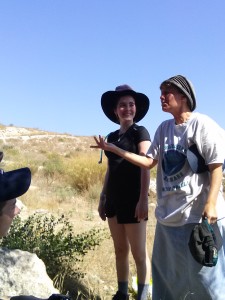
Wednesday was our first full day in Israel. We started the day with an archaeological dig at Tel Maresha, where we helped excavate a real historical site. Due to the extreme number of potential archaeological sites in Israel, archaeologists often use volunteers and tour groups to help them in their excavating. We were able to find a number of pottery shards, animal bones, and even some charcoal. It was a really cool activity, and the archaeology loving boy in me had a ton of fun.
We then went for a swim in the pool at Beit Guvrin, which was exactly what was needed for a 90 degree+ day. The day ended with a seminar on the Arab-Israeli Conflict with Neil Lazarus.
Today, Thursday, we started our learning about ancient times with exploration of the second Temple period. We started the day exploring the Southern Wall of the Temple, and learning about the daily life at the Temple, and stopped into the Davidson center for a break and a movie explaining more about life in the second Temple period.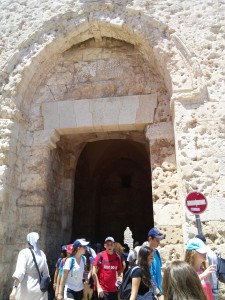
We briefly greeted the Kotel, or the Western Wall, and the USYers had a chance to write notes if they wanted. We explored the remnants of the Herodian mansions that lie underneath the streets of the old city, and learned about the warring factions of the time, the Sadducees and the Pharisees.
Our day trip ended with a visit to the Israel Museum, where we saw the Heliodorus Stele, an ancient document written on stone from around the time of the Maccabees that was actually found at Tel Maresha. We continued to see a few more artifacts, browsed the Shrine of the Book containing the Dead Sea Scrolls, and saw the giant model of Herodian Jerusalem.
I had some free time in the afternoon where I got to catch up with some friends in Israel, and it was really great to see them. We ended the day with a trip to Ben Yehuda Street, where Gonen, one of my co-staff, showed me some great places to shop and eat for the future.
A few more days in the Jerusalem area, and then we’re off to see the rest of Israel! More to come soon!
Israel: Weekend #1
I last checked in with you fine folks a week ago Thursday, when Operation Protective Edge was just a seedling. Since it has become a full fledged operation, but that hasn’t stopped our ability to see Israel and enjoy the land.
Last Friday was the first Friday of Ramadan, and as such, there were many protests and at times physical riots in the East Jerusalem neighborhood. As safety is our primary concern, we changed what was supposed to be an day exploring the First Temple period in Jerusalem to a hike and exploration of the terrace farming system that dated back to the time of First Temple in the surrounding Jerusalem area. We also explored a few water caves in that area.
We had a wonderful lunch, and headed back to Jerusalem to give the USY’ers some time to explore Machane Yehuda, and to buy gifts for their Shabbuddy (Shabbat Buddy). I went and found my coke in a glass bottle (my favorite), and bought some fresh chocolate rugelach.
We welcomed Shabbat as a group by davening at Yemin Moshe, overlooking the old city of Jerusalem. We had a very nice Kabbalat Shabbat and Ma’ariv, and headed back to our hostel for Shabbos dinner. As was my tradition when I was a madrich at Herzl, I told those sitting around me a story on Shabbos evening, this time the story of Yossele the Holy Miser (a Carlebach story, of course). After dinner, we sang a spirited ruach session, and went to bed for the night.
The next morning I took a group of kids to daven at the Great Synagogue. Not sure who the Hazan was, but from what I could understand it was a different one than usual, and there was no choir, which I understand they also usually have, but it was still a nice service, and the shul is absolutely beautiful. Their ark alone had something like 20 Torahs in it, from what I could count.
Services ended very early, so instead of free time, I told our group to grab any food they might have, and meet up on the balcony, where we had a nice oneg and traded off telling our favorite Jewish stories. We also sang some, and as other groups returned from davening, they joined us as well.
We had kiddush at Rabbi Paul Friedman’s apartment, and both he and his lovely wife welcomed our group into their home with food, stories, and a kiss on the cheek for each of us. We returned for lunch, ruach, and some much need Minuha (rest time). During the afternoon free time, I took a group of kids to throw a disc around the near by park. It was nice to have a Frisbee back in my hands again. We concluded the night with Pirkei Avot study, mincha, dinner, more ruach, and havdallah.
Sunday, we visited Yad L’Kashish, where elderly people are given food and housing to make a variety of wonderful Judaic products. While touring the factory, our kids interacted with the elderly, making conversation in Hebrew, English, and even Spanish. They took pictures with some of the workers, and to see the smiles on both the USY’ers faces and the elderly’s faces was truly heartwarming.
We spent the afternoon touring Yad Vashem, Israel’s Holocaust Museum. While the museum is always meaningful, I, and many of the USY’ers, found it hard to concentrate and find meaning in it, especially when we had experienced and learned about many of the sites in person the previous week. While it would have been a great way to summarize our experience when we first arrived in Israel, doing at the end of the first week lost some of its power and meaning.
We then spent Sunday afternoon heading south.
While I have so much more to catch up on, alas, I’m running out of time before Shabbat, so I’ll have to finish updating you all another time!
Have a quiet and peaceful Shabbat!
The Third Temple
Yesterday was Tisha B’av. If you’ve never been to a Jewish summer camp near the end of the summer, or don’t have a triple degree in Talmud, Jewish Studies, and Hebrew, then chances are you haven’t heard of the “holiday”.
Tisha B’av is the saddest day of the Jewish year, a day of mourning and a day of fasting. We commemorate the destruction of the First and Second Temples, the defeat of the Bar Kochba Revolt and the fall of Beitar, the beginning of the Spanish Inquisition and the expulsion of Jews from Spain, and the commencement of the deportation of the Warsaw Ghetto Jews to Treblinka during the Holocaust, among other calamities. As a result of this day of mourning we fast, sit on the ground (not on chairs), and generally refrain from pleasurable things.
The past few years (except last year), I had been at Herzl Camp over Tisha B’av. There, a large portion of the community fasts together, and we all partake in the reading of the Book of Lamentations and the Book of Job as is the custom. We also typically showed the movie “A Hero in Heaven”, a tribute to the life of Michael Levin, an American who made Aliyah and gave the ultimate sacrifice while fighting in the Second Lebanon War. Michael, too, was buried on Tisha B’av. Here at camp, I thought I understood Tisha B’av.
Back in 2008, I explored Israel on Alexander Muss High School in Israel. I learned Jewish history from beginning to the present. I understood the importance of remembrance. I understood the modern importance of the lessons of the First Temple, as idol worship and corruption were the cause of its collapse. I understood the importance of the lessons of the Second Temple, where sinat chinam, baseless hatred, caused the Temple to be destroyed. I understood the importance of a Jewish state, and the need to protect and defend it at all cost. But yet, Tisha B’av was just another day to me, another ritual rooted in ancient (or seemingly ancient) times.
That changed this year. This year I’m fortunate to have spent Tisha B’av in the Third Temple. No, I’m not breaking some major news story where the Jews have destroyed the Al-Aqsa Mosque and rebuilt a grand and glorious new temple. No, this temple was created in 1948, with a victory over the surrounding nations in the War for Independence, and still stands to this day. This temple is Medinat Yisrael, the State of Israel.
This Tisha B’av, and actually this whole week, I’ve been volunteering at a vineyard in the Kinneret region up north, in St. Paul’s partnership region. As I fasted, for the first time, I got to work the land of Eretz Yisrael. I got to experience and take part in the constant rebuilding of the Third Temple by helping to make this land beautiful and prosperous. This contrast between the fast and the labor, between the remembrance of what was and the reality of what now is, is an experience that is not lost on me, and that I will take with me the rest of my life. We are here now, and we’re not going anywhere.
Once again, there are people the world over that call for the destruction of the State of Israel and the elimination of the Jewish people. Like it or not, they are on our doorstep and ready and willing at a moment’s weakness to strike. We’ve unfortunately seen it these past few weeks, where the people of Israel and Jews across the world have witnessed the terror of those who want to destroy us. We have also seen, however, a Jewish unity unlike anything we have seen in a long time. Jews from all over the world stood up for their brethren, and raised their voices together in support of the Israeli people.
Let us continue to heed the lessons of Tisha B’av, of the First and Second Temples, of the Inquisition, of the Holocaust, and let us recognize that UNITY, and only unity, will leave us victorious in this time of the Third Temple. Together, as a Jewish community, we can and must stand for what is right and just in the world. We can and must fulfill our purpose of being a beacon of light, peace, and prosperity unto the nations. This, I believe, is our mission, and our duty. And only together, we can make it a reality.
Why Isn’t My Kid Jewish? Lessons of a USY Pilgrimage Madrich
It’s the last day of USY Poland-Israel Pilgrimage. We’re standing at Robinson’s Arch, in the “egalitarian” section of the Kotel, also known as the Western Wall. All 47 of us are there together, all by ourselves, ready to daven Sunday Shacharit. The men have kippot on, as well as a tallis and t’fillin. Some of the women wear a tallis, if they brought one on the trip. Before we start, I ask the women if anyone wants to wrap t’fillin, as I’d be happy to share mine for the second half of the service. After all, that previous Friday at Shacharit, the women had been taught how to wrap t’fillin, along with the reasons for why we do it. I think it would be especially meaningful for some of them to wrap at the Kotel. It turns out I’m right. Immediately after the question is raised, one girl shouts “I do!”. Taking my lead, a few of the other USY’ers pledge theirs for the second half of the service to any willing ladies who also want to wrap.
Business settled, we begin our service. Today’s leader is Briana, a USY’er from Florida whose T’fillah goal is to learn and lead a weekday Shacharit service. Standing next to her, calling pages and giving moral support, is Josh, a Rel Ed (a position on a USY board that oversees religious education for their chapter/region/country) who had both led many services on our trip and taught other USY’ers skills so that they could also lead. In a really moving and beautifully led service, all 47 of us pray together as one, each of us in our own way.
After the Amidah, I unwrap my t’fillin and hand it over to one of the ladies. I help her to wrap them, and she stands there, shoulder to should with others who have put on t’fillin, heads pressed against the great stones once supporting the Holy Temple, davening with intense kavannah (intention).
It’s such a moving scene, to see 42 USY’ers, Conservative Jews, taking on their role as young Jewish adults in such a reaffirming way. To see egalitarianism alive and thriving in this moment, in Israel, at the Kotel of all places, is inspiring.
Overlooking our platform where we’re davening, another tour group gathers, equally as moved by the experience. They stand there watching, and even join as we joyously sing the Shehecheyanu to celebrate Briana’s achievement. This excitement for Judaism, for ruach after meals, and even for prayer, is not an isolated incident on our trip. Time and again, these young USY’ers, some of whom may not have stepped into a synagogue since their B’nai Mitzvah (at least for services), prove that they’re willing and excited to partake in Jewish life in its fullest.
Are these youth outliers? Are they fundamentally different from all other American Jewish youth? Why, back home, are parents of children all across the nation asking, “Why isn’t my kid Jewish?”
“Why isn’t my kid Jewish?” I’m not here to judge what makes a person “Jewish”. That you can decide. But one thing that studies like the infamous Pew Report, and my own experience working in the Minneapolis Jewish Community has shown, is that in increasing numbers young Jews don’t identify as being Jewish. Many don’t practice Judaism on a day to day basis, a weekly basis, or even on a yearly basis. The idea of a 3 day a year Jew is an unfortunately prevalent one. Parents, synagogues, and communities have been brainstorming ways for years to change this trend, to limited success. But there have been shining stars.
“The success of the Jewish summer camp” and “experiencing Israel” have been rightly heralded for their outstanding work in creating knowledgeable Jews who are proud of their identity. How do they do it? There are many factors, but simply put, and I believe most importantly, there’s Jewish immersion.
For 1, 4, 8 weeks, Jewish youth at summer camps are, as a former camp director describes it, put in a secluded bubble and pelted from all directions with little tidbits of Judaism. Every action, be it eating, praying, playing sports, or art, is infused with Judaism and pride for Israel, both overtly and subconsciously. To many campers, saying HaMotzi before a meal or Birkat Hamazon is as much camp tradition or just another part of a meal as it is “prayer”. For many, ruach (song sessions) during Shabbat is a big highlight of their experience. Many don’t even realize that the words they sing are from our t’fillot.
An Israel experience is quite the same, in the sense that a Jew often feels completely “at home” as a Jew in Israel. To be a Jew in Israel does not make you different and restrict you from actions, as it might in America, but it connects you to the majority of the people around you. The language, the ability to wish anyone on the street a Shabbat Shalom on Friday afternoon, the ability to go into almost any restaurant you want and be able to order anything from it, all add to this feeling of Jewish immersion.
So when my Rabbis and community ask, “How can we bring the success of camp and Israel back into our community?”, the answer is not the one that they want to hear, because it is the one they have the least control over. While synagogues and communities can certainly do more to offer meaningful, engaging, and fun programming, and they can create excitement at their events similar to a camp atmosphere, the issue of Jewish engagement, and the ultimate solution, lies with those same people who are asking “Why aren’t my children Jewish?”. The issue, and the solution, lies with the parents.
It lies in the parents who drop their children off at Hebrew school on Saturdays, and then go to yoga class (or worse, the parents that bring their children late because they were at yoga). It lies in the parents that prioritize a high school football game over a Shabbat dinner. It lies in the parents who took a break from Judaism at age 13, and who forgot to come back 30 years later.
Judaism is not just a series of blind acts of faith, one followed by another. It is a series of lessons and values that makes us better people and guides how we should treat others in this world. Shabbat teaches us the importance of family, of differentiating between right and wrong, of the value of time. Kashrut teaches us the value of treating everything in this world with respect, care and dignity. Prayer teaches us the value of community and personal reflection. If not from Judaism, where are our children learning these lessons? From TV? From their friends? From popular culture?
Jewish children need Jewish immersion. They crave Jewish immersion, and are inspired by Jewish immersion to live more “Jewish” lives. The success of Jewish camps and Israel trips is impressive and important. But how much more of an impact can it have coming from a parent? From your first heroes in life? From the people you model yourself after and in many ways become? This is how we renew Jewish life.
Parents, you don’t have to do all. Start small and choose one thing. Light the Shabbat candles on Friday night. Bless your children before Friday dinner. Go to synagogue with them on Saturday mornings. Try not mixing milk and meat in your meals. Only eat kosher animals, even if the meat itself is not kosher. By doing these things, you’re showing your children that you care about Judaism. You’re showing them that it’s important to you. Only then will it become important to them.
Immersion in many ways is a relic of the past, but it is also the future. Jewish camps and Israel trips have figured this out. Will our families figure it out too before it’s too late?
